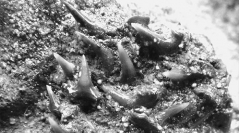

 Geodiversitas
40 (25) - Pages 557-574
Geodiversitas
40 (25) - Pages 557-574An articulated skeleton of a palaeospinacid shark from the Saint-Pô Formation (Albian, upper Lower Cretaceous) of the Boulonnais (northern France) is described and illustrated for the first time, inclusive of tooth vascularisation and histology. The specimen comprises portions of the neurocanium, splanchnocranium, pectoral girdle, vertebrae, numerous teeth and about 12 000 dermal denticles, but no dorsal fin spines. Its dental morphology is unique in combining relatively smooth crown surfaces in anterior teeth, a strongly reticulated ornamentation in latero-posterior teeth and an intermediate ornamentation in larger antero-lateral teeth. The differential diagnoses of three nominal species of Synechodus Woodward, 1888 that have often been recorded from Albian strata (i.e., S. dubrisiensis (Mackie, 1863), S. nitidus Woodward, 1911 and S. tenuis Woodward, 1889) were based mainly on tooth ornamentation. This observation would favour the conspecificity of these three forms, as has been suggested previously by several authors. However, it does not rule out the possibility of more than one species of Synechodus in the Albian of the Anglo-Paris Basin. Such divergent ornamentation might be characteristic of more than one species, meaning that differentiation would be more complex. Awaiting a thorough revision of these taxa, a review of their taxonomic history is presented here. For the time being, the specimen from the Boulonnais is left in open nomenclature and referred to as Synechodus sp.
Europe, Lower Cretaceous, Palaeospinacidae, skeleton, vascularisation, comparisons